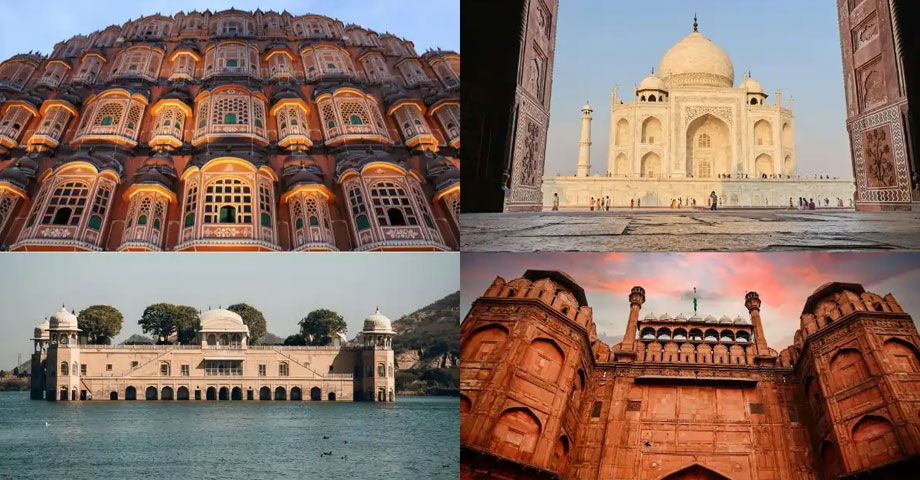- Have Any Question ?
- +91-9929358785
- 01414054824
- Info@thepinkcityholidays.com
Best Places and Times for a Spiritual Trip in the Golden Triangle

Unexplored Tourist Places in Rajasthan
May 13, 2025
How do I plan a luxury vs budget-friendly trip to the Golden Triangle?
May 13, 2025Indian tourism’s most renowned travel route, “Golden Triangle Tour” connects Delhi, Agra and Jaipur. This travel route is famous for its ancient monuments, beautiful architecture and vibrant culture. Beyond the towering palaces and forts, however, this route offers a profound spiritual experience that will appeal to individuals of all religious and spiritual persuasions. In this article, we’ll discuss how this track has offered a rewarding experience.
The Golden Triangle’s Spiritual Essence:
The Golden Triangle Tour represents the confluence point of India’s various religious traditions. For centuries, Delhi, the capital of the country, has been a seat of power with dynasties rising and falling, each leaving a spiritual heritage. Sufi saints and Mughal piety are also found in Agra; the city houses the renowned Taj Mahal. Jaipur, the Pink City, is steeped in Rajput tradition and famed for its ancient temples and deep respect for nature. The travellers can experience varied expressions of piety and spirituality by going on a spiritual pilgrimage through these cities. It presents a unique blend of Sikhism, Islam, Hinduism, Jainism and even Baha'i faith.
Delhi: A Kaleidoscope of Faiths
The spiritual climate of Delhi is as diverse as its people. The city offers a range of experiences to spiritual seekers:
Akshardham Temple is a devotion to Swaminarayan, demonstrating ancient Indian architecture, culture, and spirituality. It presents the values of harmony, peace and devotion without self, as through its massive sculptures, its large gardens and a boat ride, it illustrates the history of India.
The Lotus Temple remains open to everyone regardless of religion, designed in the shape of a lotus flower in bloom. Its peaceful environment and minimalist architecture encourage contemplation for everyone.
Bangla Sahib Gurudwara is one of the most popular Sikh gurudwaras in Delhi, and is a center of peace and love for the locals.
Nizamuddin Dargah is a hub of religious activity, especially on Thursday nights when the atmosphere is alive with qawwali sessions.
Jama Masjid evokes admiration and reverence because of its colossal size and historical importance.
Agra: Mughal Architectural Paradise
The Taj Mahal is often interpreted as a symbol of love; the Taj Mahal is also a strong symbol of Mughal Islamic worship and architecture. A feeling of religious association with the holy and eternal passion is created by the geometric patterns, the calligraphy of Quranic writings.
The mosques and prayer halls of Agra Fort and Fatehpur Sikri, two World Heritage Sites, speak a lot about the spiritual orientation of the Mughal rulers. Akbar had the blessing of the Sufi saint Sheikh Salim Chishti, whose Dargah and Jama Masjid.
Jaipur:
The traditional Rajput customs and respect for the natural world and gods are the foundation of Jaipur’s spirituality.
Galtaji Temple, or the Monkey Temple, is nestled in the hills beyond Jaipur and is famous for its natural spring that feeds seven sacred kunds. The temple complex’s unique charm is added to by the huge population of monkeys that inhabit the stunning Aravalli hills.
Laxmi Narayan Temple is otherwise known as the Birla Mandir. A modern white marble temple was built by the Birla family to Lord Vishnu and his wife Lakshmi. It is a peaceful retreat with its spotless build, intricate carvings and peaceful atmosphere.
Govind Devji Temple is the royal family complex housing the statue of Lord Krishna, believed to have been shifted from Vrindavan, which resides there.
Hawa Mahal’s stunning architectural marvel allows the royal ladies to observe everyday life and processions. Several windows are offering a discreet connection between the profane and the sacred by looking down on temples and other places of worship.
Conclusion –
An integrated experience that brushes against the essence of India’s multifaith heritage, a spiritual tour through the Golden Triangle is far more than sightseeing. Travellers can find inner peace, learn more about commitment, and leave India with lots of memories.





